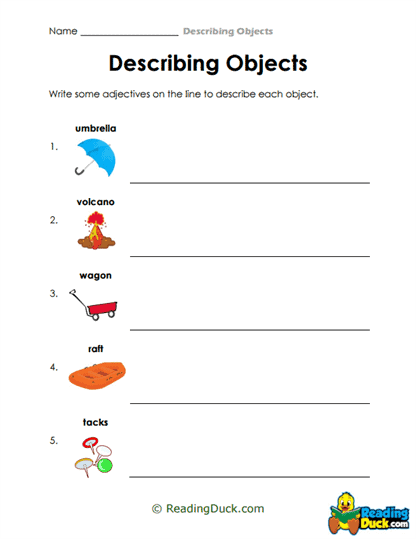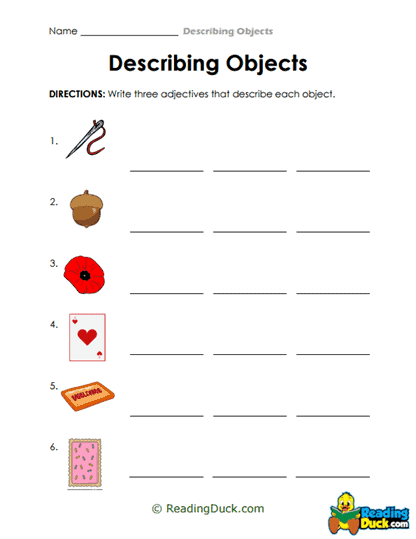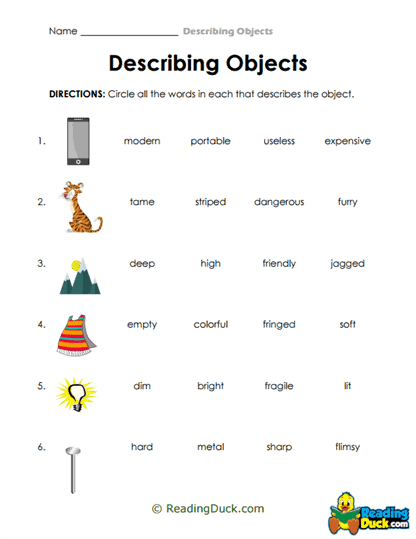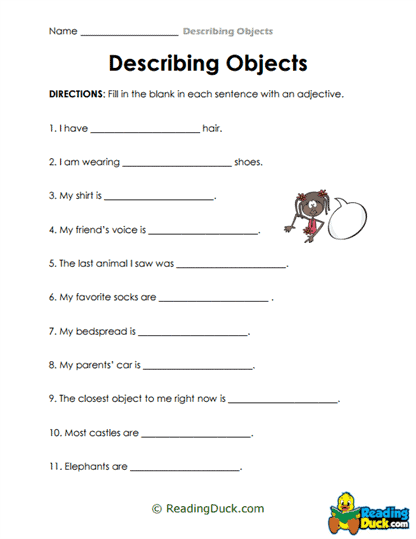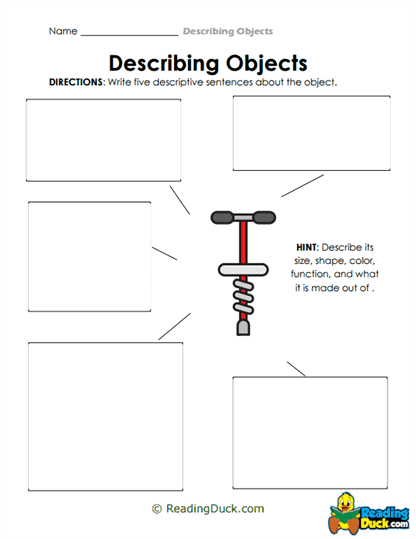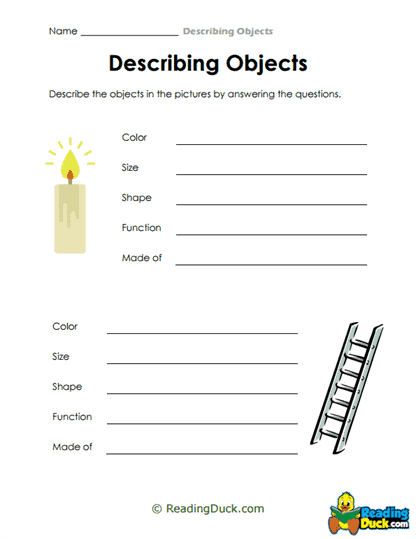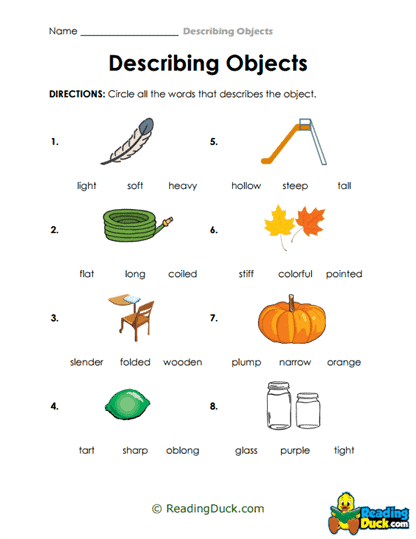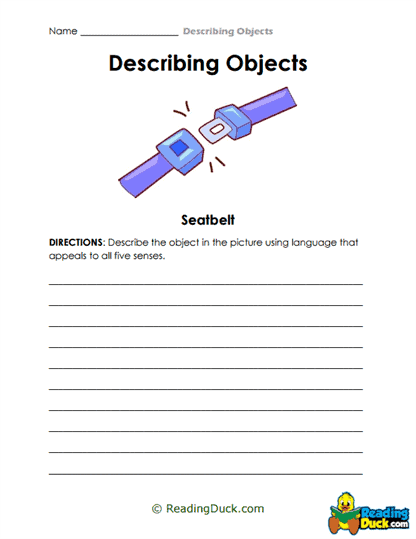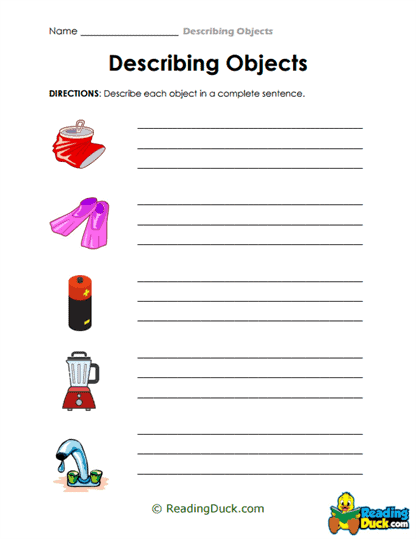Describing Objects Worksheets
About Our Describing Objects Worksheets
Our collection of Describing Objects Worksheets is a versatile resource designed to enhance students' descriptive writing skills. These worksheets guide learners through the process of vividly and accurately describing everyday objects using sensory details, precise language, and rich vocabulary. By mastering the art of description, students can improve their overall writing abilities, making their stories, essays, and reports more engaging and detailed.
Targeted for elementary and middle school students, this worksheet collection is perfect for various learning environments, including classrooms, homeschooling, and independent study. Each worksheet includes exercises that teach students how to observe, analyze, and express their thoughts about an object using detailed descriptions. Through consistent practice, students will develop the ability to create clear and compelling writing that captures their readers’ attention.
Understanding Descriptive Writing: Describing Objects
Descriptive writing focuses on using detailed observations and sensory language to create vivid images in the reader’s mind. When describing objects, students must go beyond simple physical characteristics and explore how the object feels, smells, sounds, and even tastes, depending on the context. Describing objects is an essential skill that helps students communicate clearly and enhances their ability to write more creatively and effectively.
Key aspects of describing objects:
- Sensory details: Describing an object involves engaging the five senses: sight, sound, touch, smell, and taste. Sensory language helps make descriptions more immersive for the reader.
- Precise vocabulary: Using specific adjectives and nouns helps paint a clearer picture. Instead of saying “a nice chair,” students can describe it as “a comfortable, cushioned chair with soft, velvet upholstery.”
- Comparison: Analogies and similes (e.g., "as smooth as silk") can help students describe an object more vividly by comparing it to something familiar.
- Observation skills: Encouraging students to take a closer look at the objects around them helps develop their attention to detail, an important skill in both writing and daily life.
For example:
- Basic description: The apple is red.
- Enhanced description: The shiny, bright red apple is firm to the touch, with a sweet, crisp smell that suggests its juicy flavor.
By practicing object descriptions, students learn how to break down what they see and experience into words that convey not just the appearance but the essence of the object.
How Our Worksheets Align with Writing Curriculum Goals
Our Describing Objects Worksheets are designed to meet key learning objectives found in writing curricula, providing students with valuable practice in several essential areas. The worksheets align with specific goals that improve sentence structure, descriptive clarity, and writing coherence. Teachers and parents can use these worksheets to ensure students are meeting grade-level writing standards.
Here’s how these worksheets connect with learning objectives:
- Building sentence structure: Students practice writing varied and detailed sentences, helping them avoid repetition and improve the flow of their writing.
- Enhancing descriptive clarity: By focusing on precise language and sensory details, students learn to express their ideas more clearly, creating vivid images in the reader's mind.
- Coherence and logical flow: As students work through these exercises, they learn how to organize their descriptions in a way that flows naturally, making their writing easier to read and more engaging.
These worksheets can also be integrated into larger writing units, such as creative writing projects or expository writing assignments. For instance, teachers can pair descriptive writing lessons with narrative writing tasks, where students describe objects that play important roles in their stories. In a science unit, students might use the skills learned in these worksheets to describe objects they observe in experiments, reinforcing both scientific and writing skills simultaneously.
Encouraging Creativity and Expression in Descriptive Writing
Describing objects goes beyond simply listing characteristics; it’s a powerful way for students to explore their creativity and develop their unique writing style. Our worksheets encourage students to experiment with language, expand their vocabulary, and think critically about how they perceive the world around them. This process not only strengthens their writing skills but also fosters a sense of curiosity and creativity.
Here’s how these worksheets foster creativity:
- Creative word choice: Students are encouraged to use rich and varied vocabulary, replacing common words with more descriptive terms that better capture the essence of the object they are describing.
- Personal expression: Describing objects allows students to express their individual perspectives, as they are guided to write about how an object makes them feel or what memories it evokes. This personal connection makes writing more meaningful.
- Imaginative comparisons: Students can use metaphors and similes to draw connections between the objects they describe and the world around them, adding an imaginative twist to their descriptions.
For example, rather than describing a table as "brown and sturdy," students might write, "The mahogany table gleamed under the light, its smooth surface reflecting the warmth of the afternoon sun, like a polished treasure chest waiting to be opened." This kind of description encourages students to think creatively and engage with their writing in a more dynamic way.
By giving students the freedom to explore their writing style, these worksheets help them build confidence and develop their voice, skills that are crucial as they advance in their writing journey.
Clear Instructions and Simple Preparation
Our Describing Objects Worksheets are designed to be user-friendly, with clear, step-by-step instructions that make them accessible to students of all skill levels. These worksheets are straightforward and require minimal preparation, making them ideal for teachers, parents, and independent learners alike.
Each worksheet contains:
- Clear examples: To guide students, the worksheets provide examples of how to describe objects effectively, showing the difference between basic and enhanced descriptions.
- Structured exercises: Students are led through a series of prompts and exercises that encourage them to practice describing various objects. These exercises progress from simple to more complex, allowing for gradual skill development.
- Opportunities for reflection: Some worksheets include space for students to think about how they might improve their descriptions or add more details, fostering self-assessment and growth.
Because of their clarity and structure, these worksheets can be easily incorporated into a lesson plan without requiring extensive preparation time. Teachers can use them as part of a writing workshop, a daily warm-up activity, or as homework to reinforce descriptive writing skills. Parents can also integrate these worksheets into their homeschool curriculum, ensuring their children practice valuable writing skills regularly.
Adaptable for Any Learning Environment
One of the key strengths of our Describing Objects Worksheets is their adaptability. Whether used in a traditional classroom, a virtual learning setting, or at home, these worksheets provide a flexible, practical tool for improving descriptive writing skills.
- Classroom use: Teachers can use the worksheets as part of a larger unit on descriptive writing or as a standalone resource to reinforce specific skills. They can be used for individual work, group activities, or even peer-review exercises.
- Remote learning: The worksheets are easy to distribute digitally, making them an excellent option for online learning environments. Students can work on them independently at home, then share their writing with the class via digital platforms.
- Homeschooling: Parents can include these worksheets in their daily writing practice routine. With their clear instructions and varied exercises, students can work on improving their descriptive writing without constant guidance, making them ideal for independent study.
- Independent study: Motivated students can use these worksheets on their own to practice and refine their writing skills. The exercises offer structured guidance while also encouraging creativity, making them a perfect resource for students who enjoy writing and want to improve on their own.
No matter the learning environment, these worksheets provide a flexible and effective way to teach and practice descriptive writing. Teachers and parents can easily adapt the exercises to meet the needs of different students, ensuring that all learners benefit from the practice.
Our Describing Objects Worksheets offer a comprehensive and engaging way for students to improve their descriptive writing skills. By focusing on sensory details, precise language, and creative expression, these worksheets help students learn how to craft vivid, engaging descriptions that enhance their writing. Whether used in classrooms, homeschooling settings, or for independent study, these worksheets provide structured, practical exercises that align with key writing objectives and foster creativity.
With clear instructions, minimal preparation required, and adaptability across various learning environments, these worksheets are an essential tool for educators, parents, and students alike. They not only help students master descriptive writing but also encourage them to explore their own unique voice and style, setting them up for success in all areas of writing.
